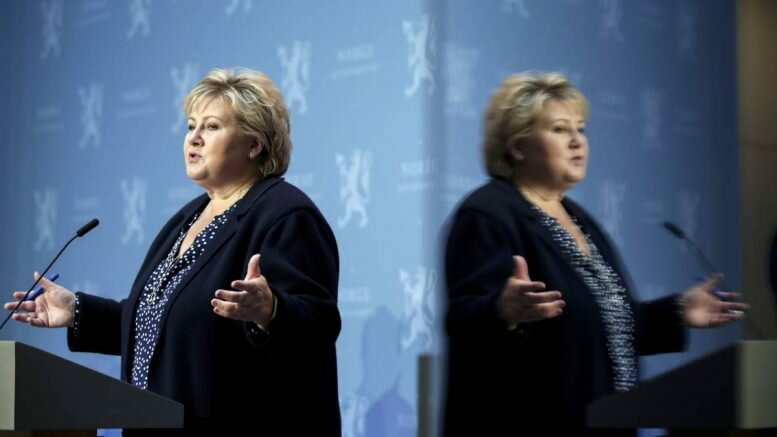On Monday, the Norwegian government presented three potential pathways for the pandemic and infection control measures going forward: an optimistic scenario, a middle-ground scenario, and a pessimistic scenario.
“We do not know how the infection situation will develop in 2021. Therefore, the government has considered three different scenarios for the pandemic that can form the basis of future management strategies.
“The scenarios take account of the uncertainty about how the pandemic will develop, the infection control measures, and the Norwegian economy,” Minister of Health and Care Services Bent Høie said.
“The most important contribution to activity, employment, and growth in the Norwegian economy will be that the virus no longer poses a threat to public health, so that the strict infection control measures may be discontinued. We can then go more back to our way of life before,” he added.
The government’s goal of being in control of the spread of infection at all times remains unchanged.
To succeed in its work of controlling the infection rate, the government plans to continuously try to strike a balance between taking a precautionary approach and acting quickly enough and ensuring that the measures are proportionate – seen in light of the infection situation.
“In Norway, we have managed to keep the infection rate lower than in many other countries, but the occurrence and possible spread of new mutated variants entail greater uncertainty in the near future. There is still major geographical variation in the infection rate across the country, which must also be expected going forward,” the government’s press release stated.
When the pandemic is nearing the end
The government noted that infection control measures would be necessary for as long as the population lacks immunity to the virus.
Vaccination will gradually contribute to achieving such immunity. Therefore, it is necessary to plan for a future situation where there is again greater certainty about the expected development.
When assessing infection control measures, interests of life and health and of children and young people will be given the highest priority, followed by the interests of workplaces and the business sector.
The government will follow the principles of the long-term strategy, including in the de-escalation phase. If possible, measures should be local rather than national.
They must be implemented gradually to maintain control and be sufficiently strong to provide the necessary infection control effect, but not be more invasive nor prolonged for the population and businesses than necessary.
“It is too early to say when the infection control measures should be discontinued or the order in which this should take place. Measures that we all know well: to keep our hands clean, stay at home if we are ill and keep our distance, will be continued for a long time. Other measures will be eased or discontinued as quickly as infection control considerations permit,” Høie noted.
The government will also work on a framework for assessing the proportionality of the measures and the overall burden of the measures so that the right measures can be prioritized during the de-escalation phase.
Three scenarios for the pandemic
Several factors will affect how the pandemic develops going forward: the availability and effect of the vaccines, new virus variants, the population’s trust and compliance with infection control measures, testing and infection tracing capacity, the development in the rest of Europe, and the scope of measures aimed at limiting imported infection.
The three scenarios, to which the Norwegian Institute of Public Health (FHI) and the Norwegian Directorate of Health have provided input, show that there is great uncertainty about the course of the infection, infection control measures, and the Norwegian economy throughout 2021.
Optimistic scenario:
- Important preconditions are realized.
- More vaccines are approved, and the manufacturers are able to offer more, enabling everyone in the risk groups to receive a vaccine by Easter.
- The rest of the adult population will be offered a vaccine before the summer holiday.
- Mutated variants of the virus do not manage to gain a foothold but are kept under control through testing and tracing.
- Positive data is reported about the effect of the vaccines on infection and contagion.
- The developments are promising across Europe.
- At best, most of the infection control measures can be discontinued before summer.
- Many of the economic measures will be removed from the second quarter, and most measures to compensate for the loss of income and turnover can be discontinued in the course of the second quarter.
- The economic policy’s main objective in this scenario must be to get people back into employment as quickly as possible, possibly even leading up to the summer. Much of the activity must then be planned and prepared early, possibly from Easter.
Middle-ground scenario
- Certain incidents may have an impact on important preconditions.
- Vaccine deliveries are delayed, and mutated variants of the virus manage to gain a foothold but are kept under control through testing and tracing.
- Everyone in the risk groups is offered a vaccine before the summer holiday. The rest of the adult population are offered a vaccine before the end of the year.
- Some of the infection control measures can be discontinued from summer, but many will still be in place well into the autumn.
- All infection control measures, with the exception of hygiene recommendations and to stay at home when showing symptoms of illness, can be discontinued at the turn of the year.
- The need for economic measures is likely to last longer, most probably until after the summer and a fair way into the autumn.
Pessimistic scenario
- Important preconditions are lacking in several areas.
- We do not succeed in giving a vaccine to a sufficiently high proportion of the population to allow us to discontinue infection control measures in the course of the year, either because the manufacturers do not manage to deliver enough vaccines, because side effects emerge, or due to new virus variants making the vaccines ineffective, making it necessary to start immunization anew.
- Mutated variants dominate the spread of infection.
- Infection control measures are continued throughout the summer and into autumn.
- The population’s compliance with infection control measures is not as good as previously.
- Municipalities and hospitals will experience a great deal of pressure, and new extensive regional and national measures become necessary.
- The need for economic measures will be present throughout 2021, and the measures will be very extensive.
Source: Ministry of Health and Care Services / #Norway Today / #NorwayTodayNews
Do you have a news tip for Norway Today? We want to hear it. Get in touch at [email protected]





Be the first to comment on "Norway’s government presents three future scenarios for the pandemic. Here are the details"